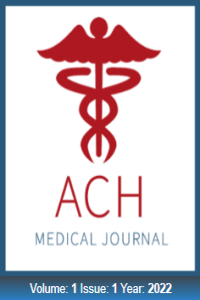The Effect of Preservation of the Bladder Neck on Incontinence Rates in Patients Who Undergo Robot-Assisted Laparoscopic Radical Prostatectomy
The Effect of Preservation of the Bladder Neck on Incontinence Rates in Patients Who Undergo Robot-Assisted Laparoscopic Radical Prostatectomy
Bladder neck sparing, Postprostatectomy incontinence, Robot-assisted radical prostatectomy,
___
- 1. Okhawere KE, Shih IF, Lee SH, et al. Comparison of 1-Year Health Care Costs and Use Associated With Open vs Robotic-Assisted Radical Prostatectomy. JAMA Netw Open. 2021;4(3):e212265.
- 2. Ilic D, Evans SM, Allan CA, et al. Laparoscopic and robotic-assisted versus open radical prostatectomy for the treatment of localised prostate cancer. Cochrane Database Syst Rev. 2017;9(9):CD009625.
- 3. Moretti TBC, Magna LA, Reis LO. Surgical Results and Complications for Open, Laparoscopic, and Robot-assisted Radical Prostatectomy: A Reverse Systematic Review. Eur Urol Open Sci. 2022;44:150-161.
- 4. d’Altilia N, Mancini V, Falagario UG, et al. A Matched-Pair Analysis after Robotic and Retropubic Radical Prostatectomy: A New Definition of Continence and the Impact of Different Surgical Techniques. Cancers (Basel). 2022;14(18):4350.
- 5. Yaxley JW, Coughlin GD, Chambers SK, et al. Robot-assisted laparoscopic prostatectomy versus open radical retropubic prostatectomy: early outcomes from a randomised controlled phase 3 study. Lancet. 2016;388(10049):1057-66.
- 6. Haglind E, Carlsson S, Stranne J, et al; LAPPRO steering committee. Urinary Incontinence and Erectile Dysfunction After Robotic Versus Open Radical Prostatectomy: A Prospective, Controlled, Nonrandomised Trial. Eur Urol. 2015;68(2):216-25.
- 7. Ficarra V, Novara G, Rosen RC, et al. Systematic review and meta-analysis of studies reporting urinary continence recovery after robot-assisted radical prostatectomy. Eur Urol. 2012;62(3):405-17.
- 8. Lavigueur-Blouin H, Noriega AC, Valdivieso R, et al. Predictors of early continence following robot-assisted radical prostatectomy. Can Urol Assoc J. 2015;9(1-2):e93-7.
- 9. Heo JE, Lee JS, Goh HJ, Jang WS, Choi YD. Urethral realignment with maximal urethral length and bladder neck preservation in robot-assisted radical prostatectomy: Urinary continence recovery. PLoS One. 2020;15(1):e0227744.
- 10. Yilmaz S, Ak E, Gazel E, et al. Bladder neck sparing during robot-assisted laparoscopic radical prostatectomy: Six-year experience. North Clin Istanb. 2021;8(3):269-74.
- 11. Dal Moro F, Zazzara M, Morlacco A, et al. Is “extreme” bladder neck preservation in robot-assisted radical prostatectomy a safe procedure? Urologia. 2020;87(3):149-54.
- 12. Kumar A, Litt ER, Ballert KN, Nitti VW. Artificial urinary sphincter versus male sling for post-prostatectomy incontinence--what do patients choose? J Urol. 2009;181(3):1231-5.
- 13. Bauer RM, Bastian PJ, Gozzi C, Stief CG. Postprostatectomy incontinence: all about diagnosis and management. Eur Urol. 2009;55(2):322-33.
- 14. Penson DF, Feng Z, Kuniyuki A, et al. General quality of life 2 years following treatment for prostate cancer: what influences outcomes? Results from the prostate cancer outcomes study. J Clin Oncol. 2003 Mar;21(6):1147-54.
- 15. Oelrich TM. The urethral sphincter muscle in the male. Am J Anat. 1980;158(2):229-46.
- 16. Steiner MS. The puboprostatic ligament and the male urethral suspensory mechanism: an anatomic study. Urology. 1994;44(4):530-4.
- 17. von Bodman C, Matsushita K, Savage C, et al. Recovery of urinary function after radical prostatectomy: predictors of urinary function on preoperative prostate magnetic resonance imaging. J Urol. 2012;187(3):945-50.
- 18. Giannantoni A, Mearini E, Zucchi A, et al. Bladder and urethral sphincter function after radical retropubic prostatectomy: a prospective long-term study. Eur Urol. 2008;54(3):657-64.
- 19. Wei JT, Montie JE. Comparison of patients’ and physicians’ rating of urinary incontinence following radical prostatectomy. Semin Urol Oncol. 2000;18(1):76-80.
- 20. Arnsrud Godtman R, Persson E, Bergengren O, et al. Surgeon volume and patient-reported urinary incontinence after radical prostatectomy. Population-based register study in Sweden. Scand J Urol. 2022;56(5-6):343-50.
- 21. Walsh PC, Marschke PL. Intussusception of the reconstructed bladder neck leads to earlier continence after radical prostatectomy. Urology. 2002;59(6):934-8.
- 22. Preisser F, Busto Martin L, Pompe RS, et al. Effect of bladder neck sparing at robot-assisted laparoscopic prostatectomy on postoperative continence rates and biochemical recurrence. Urol Oncol. 2020;38(1):1.e11-1.e16.
- 23. Freire MP, Weinberg AC, Lei Y, et al. Anatomic bladder neck preservation during robotic-assisted laparoscopic radical prostatectomy: description of technique and outcomes. Eur Urol. 2009;56(6):972-80.
- 24. Sood A, Grauer R, Jeong W, et al. Evaluating post radical prostatectomy mechanisms of early continence. Prostate. 2022;82(12):1186-95.
- 25. Li X, Zhang H, Jia Z, et al. Urinary continence outcomes of four years of follow-up and predictors of early and late urinary continence in patients undergoing robot-assisted radical prostatectomy. BMC Urol. 2020;20(1):29. Effect of Bladder-Neck Preservation on Incontinence
- Başlangıç: 2022
- Yayıncı: Ankara Şehir Hastanesi
The Need for Emergency Case Management in Family Medicine: A Capital City Case
Tuğba YILMAZ, Tarık Eren YILMAZ, Eren USUL
Management of Non-Surgical Traumatic Facial Nerve Injuries
Gökçe Naz KÜÇÜKBAŞ, Nazan AKGÜN KORUK
Tanju KETEN, Ali Yasin OZERCAN, Burak KÖSEOĞLU, Ahmet Burak YILMAZ, Ünsal EROĞLU, Yalçın KIZILKAN, Melih BALCI, Özer GÜZEL, Yılmaz ASLAN, Cüneyt ÖZDEN, Altuğ TUNCEL
Erhan Renan UÇAROĞLU, Ufuk Turan Kürşat KORMAZ, Yusuf VELİOĞLU, Kemalettin ERDEM
Influences on Family Medicine Career Choice: Implications for Healthcare Development
Şeyma Handan DOĞAN, Tarık Eren YILMAZ, Adem ÖZKARA
Bergen LALELİ KOÇ, Betül AKGÜN AKTAŞ, Osman Onur ÖZKAVAK, Atakan TANACAN, Dilek SAHİN
